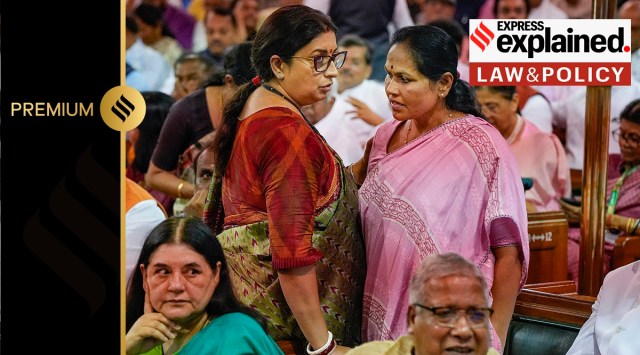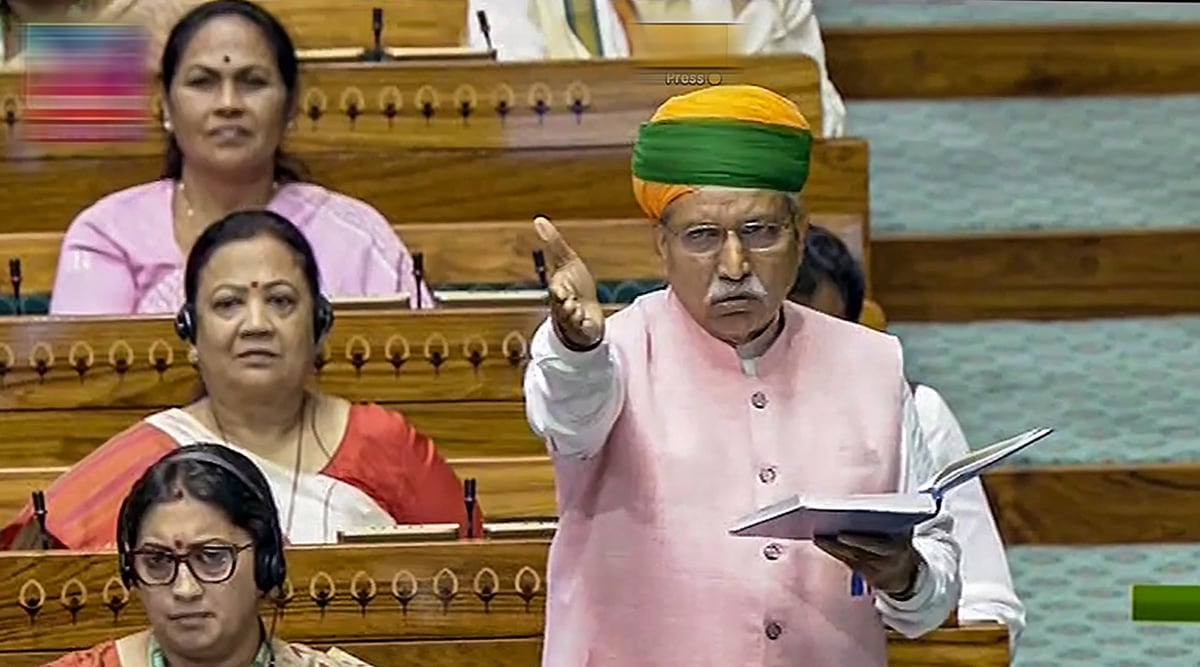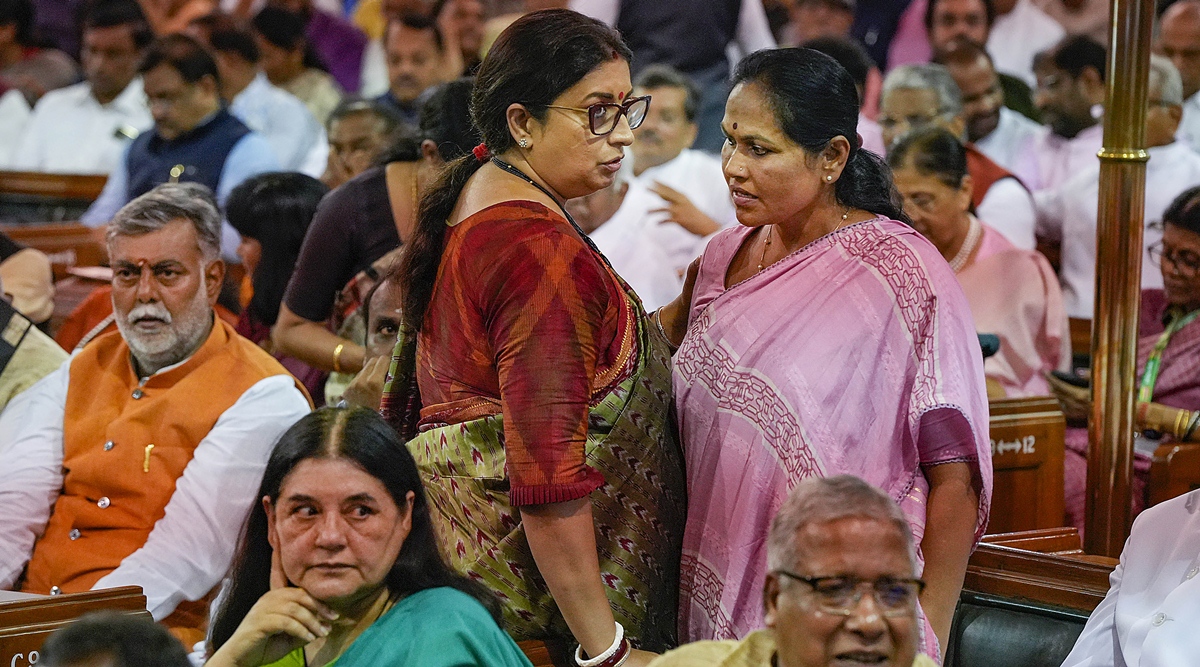According to The Constitution (One Hundred and Twenty-eighth Amendment) Bill 2023, “as nearly as maybe, one-third (including the seats reserved for women belonging to the Scheduled Castes and Scheduled Tribes) of the total number of seats to be filled by direct election to the House of People shall be reserved for women”.

The Bill proposes a similar provision for Assemblies in the states and Delhi.
 Women Members of Parliament walk to the new Parliament building on Tuesday. (PTI)
Women Members of Parliament walk to the new Parliament building on Tuesday. (PTI)
Like the previous Bill, The Constitution (One Hundred and Twenty-eighth Amendment) Bill 2023 proposes to introduce new articles — 330A and 332A — in the Constitution. These new provisions will introduce the changes for Lok Sabha and Assemblies respectively.
Like the 2010 Bill, the current one also has a sunset clause, mandating that the reservation will be for a period of 15 years from the date of commencement of the Act.
The key difference, however, is that the Bill makes the implementation of women’s reservation contingent upon the delimitation process.
So, how soon can the Bill be expected to come into effect, assuming that it is passed quickly by both Houses of Parliament, perhaps in the ongoing Special Session?
Story continues below this ad
The Bill states: “Notwithstanding anything in the foregoing provision of this Part or Part VIII, the provisions of the Constitution relating to the reservation of seats for women in the House of People, the Legislative Assembly of State, and the Legislative Assembly of the National Capital Territory of Delhi shall come into effect after an exercise of delimitation is undertaken for this purpose after the relevant figures for the first census taken after the commencement of The Constitution (One Hundred and Twenty-eighth Amendment) Bill 2023 have been published, and shall cease to have effect on the expiration of a period of 15 years from the date of such commencement.”
The upshot of these conditions is that women’s reservation may not effectively be operationalised in Lok Sabha before the general elections of 2029.
 The Bill was presented by Union Law Minister Arjun Ram Meghwal in Lok Sabha. (PTI)
The Bill was presented by Union Law Minister Arjun Ram Meghwal in Lok Sabha. (PTI)
The 42nd Amendment froze the delimitation exercise until the results of the first Census after 2000 was published. In 2001, this was further extended for 25 years. And now, delimitation would happen after the results of the first Census after 2026 is published.
In normal course, this would have meant that delimitation would happen only after the 2031 Census results were published. But now that the 2021 Census has been delayed, ostensibly because of the Covid-19 pandemic, this timeline could be altered.
Story continues below this ad
As things stand, the earliest that the Census 2021 exercise can now be expected to happen is 2025 — the houselisting exercise in 2024, followed by the actual Census in 2025. Thereafter, the publication of the Census numbers could take one or two years.
If the results of the 2021 Census are published after 2026, this could become the basis of delimitation of constituencies.
 Ministers Smriti Irani, Shobha Karandlaje and BJP MP Maneka Gandhi at the Central Hall of old Parliament on Tuesday. (PTI)
Ministers Smriti Irani, Shobha Karandlaje and BJP MP Maneka Gandhi at the Central Hall of old Parliament on Tuesday. (PTI)
How will the reserved seats be identified in the first instance, and subsequently?
The Bill states that one-third of the seats in Parliament and state Assemblies will be reserved for women. However, it doesn’t specify how these seats will be identified. It’s important to remember that this proposed constitution amendment is enabling in nature. In other words, it will grant the government the power to enact a law for its implementation. Hence, it is expected that the determination of seats will be addressed by a separate law that the government will introduce.
However, it’s important to mention here that when the UPA tried to amend the Constitution in 2010, its amendment Bill also didn’t specify the method to identify which seats would be set aside for women. But the government at the time had proposed that constituencies reserved for women would be obtained through a draw of lots to ensure that no seat was reserved more than once in three consecutive elections.
Story continues below this ad
The NDA-III government’s Bill also proposes the rotation of reserved seats. However, since the Bill was introduced in the Lok Sabha Tuesday, and the debate on the Bill will only start on Wednesday, it’s not clear how exactly the Modi government intends to identify the 33% of seats.
 Prime Minister Narendra Modi with Union Ministers Amit Shah and Rajnath Singh and other parliamentarians enters the new Parliament building, in New Delhi. (PTI Photo)
Prime Minister Narendra Modi with Union Ministers Amit Shah and Rajnath Singh and other parliamentarians enters the new Parliament building, in New Delhi. (PTI Photo)
How are the seats that are reserved for SCs and STs decided currently?
The Delimitation Act, 2002 lays down broad principles for reserving seats. The Delimitation Commission appointed under the Act is responsible for deciding the number of Parliamentary and Assembly constituencies to be reserved based on the population.
“Constituencies in which seats are reserved for the Scheduled Castes shall be distributed in different parts of the State and located, as far as practicable, in those areas where the proportion of their population to the total is comparatively large,” Section 9 (1)(c) of the Act says.
Similarly, for the Scheduled Tribes, the Act says: “Constituencies in which seats are reserved for the Scheduled Tribes shall, as far as practicable, be located in areas where the proportion of their population to the total is the largest.”
Story continues below this ad
 Prime Minister Narendra Modi with Union Ministers enters the new Parliament building, in New Delhi. (ANI)
Prime Minister Narendra Modi with Union Ministers enters the new Parliament building, in New Delhi. (ANI)
What constitutional amendments will be needed to operationalise the scheme of women’s reservation?
For delimitation — which is a precondition for the implementation of reservation — Articles 82 and 170(3) of the Constitution would have to be amended.
Article 82 provides for the readjustment of constituencies (number and boundaries) of both Lok Sabha and state Assemblies after every Census. Article 170(3) deals with composition of the Legislative Assemblies.
How does reservation for women in Panchayati Raj institutions and Urban Local Bodies work?
Article 243D of the Constitution provides for reservation of seats for Scheduled Castes, Scheduled Tribes, and women in Panchayats.
It also says that nothing in this part shall prevent the legislature of a state from making any provision for reservation of seats in any Panchayat or offices of Chairpersons in the Panchayats at any level in favour of the backward classes of citizens.
Story continues below this ad
As per the provisions of Article 243D, not less than one-third of the total number of seats reserved for SCs and STs shall be reserved for women.
According to government data, as on September 8, 2021, in at least 18 states, the percentage of women elected representatives in Panchayati Raj institutions was more than 50 per cent: Uttarakhand, Chhattisgarh, Assam, Maharashtra, Tamil Nadu, Odisha, Kerala, Bihar, Jharkhand, West Bengal, Rajasthan, Manipur, Telangana, Sikkim, Himachal Pradesh, Karnataka, Andhra Pradesh, and Madhya Pradesh.
The highest proportion of women representatives was in Uttarakhand (56.02 per cent) and the lowest was in Uttar Pradesh (33.34 per cent). Overall, there were 45.61 per cent women representatives in Panchayati Raj institutions in the country.



 Women Members of Parliament walk to the new Parliament building on Tuesday. (PTI)
Women Members of Parliament walk to the new Parliament building on Tuesday. (PTI) The Bill was presented by Union Law Minister Arjun Ram Meghwal in Lok Sabha. (PTI)
The Bill was presented by Union Law Minister Arjun Ram Meghwal in Lok Sabha. (PTI) Ministers Smriti Irani, Shobha Karandlaje and BJP MP
Ministers Smriti Irani, Shobha Karandlaje and BJP MP  Prime Minister Narendra Modi with Union Ministers
Prime Minister Narendra Modi with Union Ministers  Prime Minister Narendra Modi with Union Ministers enters the new Parliament building, in New Delhi. (ANI)
Prime Minister Narendra Modi with Union Ministers enters the new Parliament building, in New Delhi. (ANI)





































